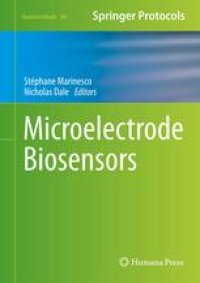
Ebook: Microelectrode Biosensors
- Tags: Neurosciences, Neurochemistry
- Series: Neuromethods 80
- Year: 2013
- Publisher: Humana Press
- Edition: 1
- Language: English
- pdf
For molecules that are not directly electroactive, it is necessary to modify a microelectrode by grafting polymeric or enzymatic membranes capable of translating a local concentration into an electrical current, which is a concept referred to as biosensing. In Microelectrode Biosensors, experts in the field cover the topic of electrochemical biosensor technology as applied to the neurosciences. The volume opens with a section addressing the specific issue of manufacturing biosensors that can be implanted in the central nervous system for neurotransmitter detection, and it then continues with sections on recent studies where biosensors have made a difference in bringing a new level of understanding of signaling mechanisms in neuroscience as well as recent developments in biosensor technology that have not yet been applied to implantable microelectrodes but may have great potential. Written for the Neuromethods series, this work contains the kind of detailed descriptions and implementation advice necessary to achieve successful results.
Focused and cutting-edge, Microelectrode Biosensors serves to inspire the wider neuroscience and physiology community to adopt these powerful methods in their own applications in order to move the field forward with the widespread advances that will most likely flow from the adoption of biosensing as part of the standard laboratory toolkit.
For molecules that are not directly electroactive, it is necessary to modify a microelectrode by grafting polymeric or enzymatic membranes capable of translating a local concentration into an electrical current, which is a concept referred to as biosensing. In Microelectrode Biosensors, experts in the field cover the topic of electrochemical biosensor technology as applied to the neurosciences. The volume opens with a section addressing the specific issue of manufacturing biosensors that can be implanted in the central nervous system for neurotransmitter detection, and it then continues with sections on recent studies where biosensors have made a difference in bringing a new level of understanding of signaling mechanisms in neuroscience as well as recent developments in biosensor technology that have not yet been applied to implantable microelectrodes but may have great potential. Written for the Neuromethods series, this work contains the kind of detailed descriptions and implementation advice necessary to achieve successful results.
Focused and cutting-edge, Microelectrode Biosensors serves to inspire the wider neuroscience and physiology community to adopt these powerful methods in their own applications in order to move the field forward with the widespread advances that will most likely flow from the adoption of biosensing as part of the standard laboratory toolkit.